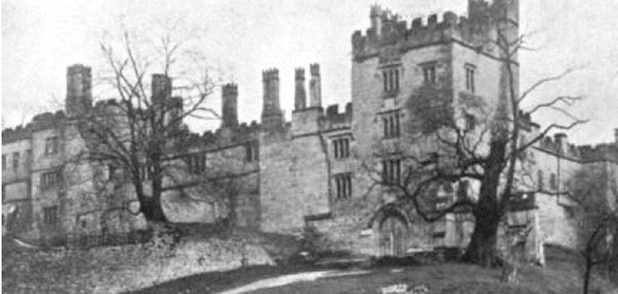The History and Antiquities of Haddon Hall
by S. Rayner
The History and Antiquities of Haddon Hall is the first historical book devoted completely to the subject of Haddon Hall. Written in 1836, it contains thirty-two drawings of the interior and exterior features of Haddon. The download RaynerHaddonHall.pdf contains the written words of Rayner's book. Part I of this book is a detailed history of how Haddon Hall was acquired by William the Conqueror in 1066, and how it passed through various noble families until its final acquisition by the Manners family in 1565. Part II is a detailed description of Haddon Hall and its grounds circa 1836, when visited by Rayner. The book contains drawings of many features of the Hall at the time of the visit; some are of areas which now are inaccessible to the twenty-first century visitor.
A second download RaynerHaddonPicture.pdf contains the thirty-two drawings to which Rayner refers in Part II of his book. It is intended that the reader refer to the appropriate page of RaynerHaddonPicture as Part II of RaynerHaddonHall is being read.
Rayner brings the legend of Dorothy Vernon into the historical mainstream: "It may be proper to notice a romantic tradition, still current in the vicinity of Haddon, relative to the courtship and marriage of Mr. Manners with the younger co-heiress of Vernon." He begins the process of interweaving Haddon Hall history, fiction, and tradition in such a way that it is difficult, if not impossible to ever separate them again. Thus begins the legend of Haddon Hall's Dorothy Vernon: either a popular myth of recent origin or a historical story handed down from early times.
Many libraries incorrectly identify S. Rayner as Simeon, who was an obscure author, rather than the correct designation of Samuel, who was a member of the renowned family of Rayner artists.
Click to download 1.0 MB PDF file
The History and Antiquities of Haddon Hall - Text : DOWNLOAD
Click to download 8.0 MB PDF file
The History and Antiquities of Haddon Hall - Illustrations : DOWNLOAD
A printed copy of the book The History and Antiquities of Haddon Hall, which includes both the Text and the Illustrations may be purchased at www.LULU.com/shop
Enter TRUTT in the Search Books box.
The articles on this page shown below have been collected into a book Haddon Hall Historical Observations. A printed copy of the book may be purchased at www.LULU.com/shop
Enter TRUTT in the Search Books box.
Observations on Ancient Castles by Edward King, written in 1782, contains the earliest full description of Haddon Hall. Rayner adapted most of it to produce the written portion of Part II of his book. It is included here to provide a more complete record of the early descriptions of the physical Haddon Hall. This was during the period when there were no restrictions on what could be accessed by the visitor.
Click to download 0.7 MB PDF file
Observations on Ancient Castles : DOWNLOAD
Peak Scenery or The Derbyshire Tourist by Ebenezer Rhodes, written in 1819, contains his original description of Haddon Hall. An 1825 visitor to the Rutland Arms, an inn owned by the Duke of Rutland in the town of Bakewell, noted the presence of Rhodes Peak Scenery placed there for the reading enjoyment of the guests.
Click to download 3.2 MB PDF file
Peak Scenery : DOWNLOAD
Haddon Hall by John Leyland, written in 1891, contains his original description of Haddon Hall. It is an excellent combination of the architectural details of the Hall combined with the family history of the Vernons and Manners, masters of the Hall from the thirteenth through the nineteenth century.
Click to download 1.9 MB PDF file
Haddon Hall : DOWNLOAD
A Guide to Bakewell and Haddon Hall by Abel Heywood, written in 1895, contains his original description of Haddon Hall. This represented the first attempt to provide low cost guide books for the general public. The working class public was beginning to use railway transit for tourism purposes rather than just to get back and forth to work.
Click to download 0.3 MB PDF file
A Guide to Bakewell and Haddon Hall : DOWNLOAD
